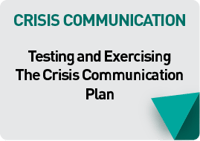 Simulation Exercises
Simulation Exercises
Regular simulation exercises are necessary. If the best plans exist only on paper, they are worthless. There needs to be regular (at least biannual) exercises conducted by the Crisis Response Team, and regular testing of channels, inventorying of resources, etc. These tests should be carried out on a regular basis, but not scheduled in order to test the speed of response.
Rehearse the Crisis Communication System
Numerous techniques from full-scale rehearsals to simple drills will be explained as the best means to optimise the Crisis Communication system.
The debriefing process whereby improvements are documented and put into an annual plan should be thoroughly discussed.
The test may be necessary to ensure an organisation’s Crisis Management Team has skilled members to respond effectively to a crisis. Typically, the need for training in the areas of crisis management, peer Crisis Simulation support, first aid training, evacuation planning and many other areas are identified.
Category of Tests and Exercises
There are several categories of tests, each introducing escalating amounts of pressure, real-time decision-making and resources. These include:
Plan Walkthroughs
These are done to introduce the plan and help the managers to gain familiarity. These may also include several "what-if" scenarios to illustrate how the plan should work.
Table-top Exercises
The Crisis Management Team or sub-teams participate in roundtable discussions led by an external moderator. A scenario is developed in advance and introduced, with the moderator communicating with participants through a chain of problems and decisions. There will be a performance analysis done at the end of the exercise.
Incident Simulation (Event Simulations)
Crisis responders gather in the Crisis Command Centre built as part of the crisis plan to react to a mock incident. (These kinds of simulations often make it in the evening news, when local police or airports conduct them.)
In general, observers are attached to each member of the Crisis Team to evaluate his or her team's performance and activities. The simulation usually lasts for several hours. There will be multiple incidents arising from the main scenario and includes a detailed analysis at the end.
Full Simulation (Full Deployment Drills)
These are usually conducted in the chemical, energy, airlines and oil industries. In full deployment drills, an incident is simulated at a preferred site, requiring equipment and responders to be deployed as they would during the occurrence of a real airline crash or oil spill. To make it realistic, these drills often go on for hours, or days, so that management teams get a true sense of tiredness and pressure as well as practicing planning cycles and shift changes.
Typically, these kinds of drills require several months of planning in advance, scrupulous attention to detail and realism, and a significant budget.
 Reference
Reference
Goh, M. H. (2015). A Manager's Guide to Implementing Your IT Crisis Communication Plan. Business Continuity Management Specialist Series. Singapore: GMH Pte Ltd.
Extracted from "Testing and Exercising the Crisis Communication Plan"
More Information About Crisis Communication Blended Learning
To know more about our blended learning program and when the next course is scheduled, feel free to contact our friendly course consultant colleagues via sales.ap@bcm-institute.org. They are the BL-CC-3 Blended Learning CC-300 Crisis Communication Implementer and the BL-CC-5 Blended Learning CC-5000 Crisis Communication Expert Implementer.
 |
 |
|
 |
 |
 |
Please feel free to send us a note if you have any of these questions to sales.ap@bcm-institute.org |


![[BL-CC-3] CC-300 Blended Learning Tell Me More](https://blog.bcm-institute.org/hs-fs/hub/3893111/hub_generated/resized/81e562e5-9ec3-4eec-a4ff-3f983c637a87.png?width=250&height=64&name=81e562e5-9ec3-4eec-a4ff-3f983c637a87.png)



